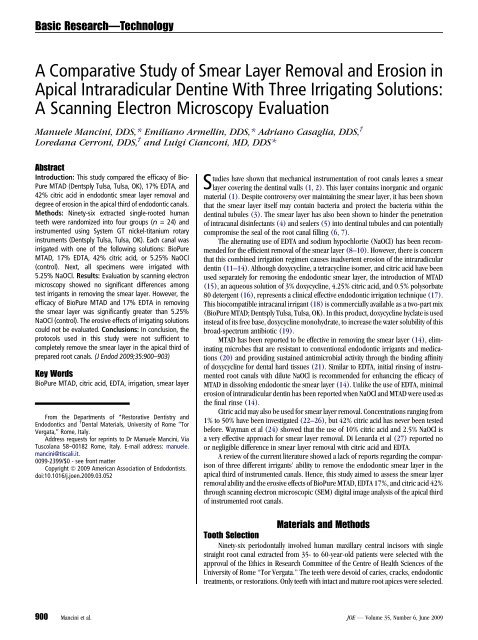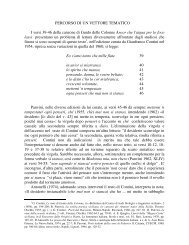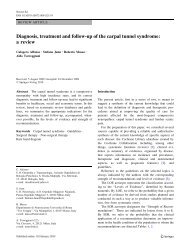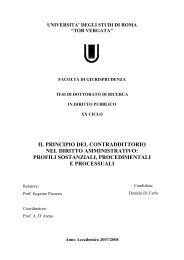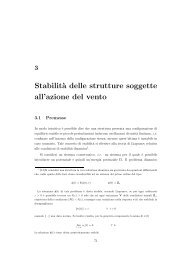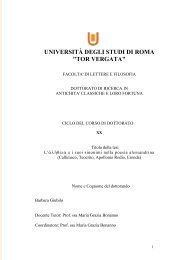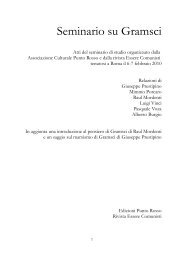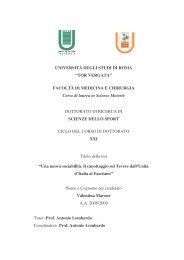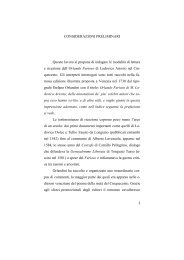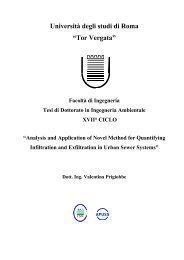A Comparative Study of Smear Layer Removal ... - Home page | ART
A Comparative Study of Smear Layer Removal ... - Home page | ART
A Comparative Study of Smear Layer Removal ... - Home page | ART
You also want an ePaper? Increase the reach of your titles
YUMPU automatically turns print PDFs into web optimized ePapers that Google loves.
Basic Research—Technology<br />
A <strong>Comparative</strong> <strong>Study</strong> <strong>of</strong> <strong>Smear</strong> <strong>Layer</strong> <strong>Removal</strong> and Erosion in<br />
Apical Intraradicular Dentine With Three Irrigating Solutions:<br />
A Scanning Electron Microscopy Evaluation<br />
Manuele Mancini, DDS,* Emiliano Armellin, DDS,* Adriano Casaglia, DDS, †<br />
Loredana Cerroni, DDS, † and Luigi Cianconi, MD, DDS*<br />
Abstract<br />
Introduction: This study compared the efficacy <strong>of</strong> Bio-<br />
Pure MTAD (Dentsply Tulsa, Tulsa, OK), 17% EDTA, and<br />
42% citric acid in endodontic smear layer removal and<br />
degree <strong>of</strong> erosion in the apical third <strong>of</strong> endodontic canals.<br />
Methods: Ninety-six extracted single-rooted human<br />
teeth were randomized into four groups (n = 24) and<br />
instrumented using System GT nickel-titanium rotary<br />
instruments (Dentsply Tulsa, Tulsa, OK). Each canal was<br />
irrigated with one <strong>of</strong> the following solutions: BioPure<br />
MTAD, 17% EDTA, 42% citric acid, or 5.25% NaOCl<br />
(control). Next, all specimens were irrigated with<br />
5.25% NaOCl. Results: Evaluation by scanning electron<br />
microscopy showed no significant differences among<br />
test irrigants in removing the smear layer. However, the<br />
efficacy <strong>of</strong> BioPure MTAD and 17% EDTA in removing<br />
the smear layer was significantly greater than 5.25%<br />
NaOCl (control). The erosive effects <strong>of</strong> irrigating solutions<br />
could not be evaluated. Conclusions: In conclusion, the<br />
protocols used in this study were not sufficient to<br />
completely remove the smear layer in the apical third <strong>of</strong><br />
prepared root canals. (J Endod 2009;35:900–903)<br />
Key Words<br />
BioPure MTAD, citric acid, EDTA, irrigation, smear layer<br />
From the Departments <strong>of</strong> *Restorative Dentistry and<br />
Endodontics and † Dental Materials, University <strong>of</strong> Rome ‘‘Tor<br />
Vergata,’’ Rome, Italy.<br />
Address requests for reprints to Dr Manuele Mancini, Via<br />
Tuscolana 58–00182 Rome, Italy. E-mail address: manuele.<br />
mancini@tiscali.it.<br />
0099-2399/$0 - see front matter<br />
Copyright ª 2009 American Association <strong>of</strong> Endodontists.<br />
doi:10.1016/j.joen.2009.03.052<br />
Studies have shown that mechanical instrumentation <strong>of</strong> root canals leaves a smear<br />
layer covering the dentinal walls (1, 2). This layer contains inorganic and organic<br />
material (1). Despite controversy over maintaining the smear layer, it has been shown<br />
that the smear layer itself may contain bacteria and protect the bacteria within the<br />
dentinal tubules (3). The smear layer has also been shown to hinder the penetration<br />
<strong>of</strong> intracanal disinfectants (4) and sealers (5) into dentinal tubules and can potentially<br />
compromise the seal <strong>of</strong> the root canal filling (6, 7).<br />
The alternating use <strong>of</strong> EDTA and sodium hypochlorite (NaOCl) has been recommended<br />
for the efficient removal <strong>of</strong> the smear layer (8–10). However, there is concern<br />
that this combined irrigation regimen causes inadvertent erosion <strong>of</strong> the intraradicular<br />
dentin (11–14). Although doxycycline, a tetracycline isomer, and citric acid have been<br />
used separately for removing the endodontic smear layer, the introduction <strong>of</strong> MTAD<br />
(15), an aqueous solution <strong>of</strong> 3% doxycycline, 4.25% citric acid, and 0.5% polysorbate<br />
80 detergent (16), represents a clinical effective endodontic irrigation technique (17).<br />
This biocompatible intracanal irrigant (18) is commercially available as a two-part mix<br />
(BioPure MTAD; Dentsply Tulsa, Tulsa, OK). In this product, doxycycline hyclate is used<br />
instead <strong>of</strong> its free base, doxycycline monohydrate, to increase the water solubility <strong>of</strong> this<br />
broad-spectrum antibiotic (19).<br />
MTAD has been reported to be effective in removing the smear layer (14), eliminating<br />
microbes that are resistant to conventional endodontic irrigants and medications<br />
(20) and providing sustained antimicrobial activity through the binding affinity<br />
<strong>of</strong> doxycycline for dental hard tissues (21). Similar to EDTA, initial rinsing <strong>of</strong> instrumented<br />
root canals with dilute NaOCl is recommended for enhancing the efficacy <strong>of</strong><br />
MTAD in dissolving endodontic the smear layer (14). Unlike the use <strong>of</strong> EDTA, minimal<br />
erosion <strong>of</strong> intraradicular dentin has been reported when NaOCl and MTAD were used as<br />
the final rinse (14).<br />
Citric acid may also be used for smear layer removal. Concentrations ranging from<br />
1% to 50% have been investigated (22–26), but 42% citric acid has never been tested<br />
before. Wayman et al (24) showed that the use <strong>of</strong> 10% citric acid and 2.5% NaOCl is<br />
a very effective approach for smear layer removal. Di Lenarda et al (27) reported no<br />
or negligible difference in smear layer removal with citric acid and EDTA.<br />
A review <strong>of</strong> the current literature showed a lack <strong>of</strong> reports regarding the comparison<br />
<strong>of</strong> three different irrigants’ ability to remove the endodontic smear layer in the<br />
apical third <strong>of</strong> instrumented canals. Hence, this study aimed to assess the smear layer<br />
removal ability and the erosive effects <strong>of</strong> BioPure MTAD, EDTA 17%, and citric acid 42%<br />
through scanning electron microscopic (SEM) digital image analysis <strong>of</strong> the apical third<br />
<strong>of</strong> instrumented root canals.<br />
Materials and Methods<br />
Tooth Selection<br />
Ninety-six periodontally involved human maxillary central incisors with single<br />
straight root canal extracted from 35- to 60-year-old patients were selected with the<br />
approval <strong>of</strong> the Ethics in Research Committee <strong>of</strong> the Centre <strong>of</strong> Health Sciences <strong>of</strong> the<br />
University <strong>of</strong> Rome ‘‘Tor Vergata.’’ The teeth were devoid <strong>of</strong> caries, cracks, endodontic<br />
treatments, or restorations. Only teeth with intact and mature root apices were selected.<br />
900 Mancini et al. JOE — Volume 35, Number 6, June 2009
After extraction, teeth were stored in 2% thymol solution at room<br />
temperature and used within 1 week.<br />
Root Canal Preparation<br />
The teeth were decoronated to standardized root length <strong>of</strong> 12 mm<br />
and randomly divided into one <strong>of</strong> four groups (n = 24). The working<br />
lengths were measured by deducting 1 mm from lengths recorded when<br />
the tips <strong>of</strong> #10 or #15 K-files (Dentsply Maillefer, Ballaigues,<br />
Switzerland) were visible at the apical foramina. The specimens were<br />
shaped using System GT Ni-Ti rotary instruments (Dentsply Maillefer,<br />
Ballaigues, Switzerland) according to the manufacturer’s instructions<br />
until System GT #30/.04 file reached the working length. Each instrument<br />
was only used for the preparation <strong>of</strong> four teeth. After using each<br />
file and before proceeding to the next, canals were irrigated with<br />
2 mL <strong>of</strong> 5.25% NaOCl at 37 C (Chematek SpA). After instrumentation,<br />
all teeth underwent final irrigation as follows: (1) MTAD group, 1 mL<br />
<strong>of</strong> MTAD for 1 minute followed by 3 mL <strong>of</strong> 5.25% NaOCl 37 C; (2)<br />
EDTA group, 1 mL <strong>of</strong> 17% EDTA (Chematek SpA) for 1 minute<br />
followed by 3 mL <strong>of</strong> 5.25% NaOCl 37 C; (3) citric acid group, 1<br />
mL <strong>of</strong> 42% citric acid (Chematek SpA) for 1 minute followed by 3<br />
mL <strong>of</strong> 5.25% NaOCl 37 C; and (4) control group, 1 mL <strong>of</strong> 5.25%<br />
NaOCl 37 C for 1 minute followed by 3 mL <strong>of</strong> 5.25% NaOCl 37 C.<br />
The irrigating solutions were delivered via a sterile 30-gauge<br />
nickel-titanium needle (Stropko NiTi Flexi-Tip; SybronEndo, Orange,<br />
CA), which penetrated to within 1 to 2 mm <strong>of</strong> the working length.<br />
The root canals then were irrigated with 5 mL <strong>of</strong> distilled water and<br />
dried with sterile paper points.<br />
Specimen Preparation<br />
An SEM was used to evaluate endodontic smear layer removal<br />
(‘‘cleanliness’’) and erosion in the apical third <strong>of</strong> the instrumented<br />
root canals. To prepare the samples for imaging, the teeth/roots were<br />
usually split longitudinally in the buccolingual plane. To facilitate fracture<br />
into two halves, all roots were grooved longitudinally on the<br />
external surface with a diamond disc, avoiding penetration <strong>of</strong> the<br />
root canals. The roots were then split in two halves with a chisel. For<br />
each root, the half containing the most visible part <strong>of</strong> the apex was<br />
conserved and coded. The coded specimens were secured on metal<br />
stubs, desiccated, sputter coated with gold, and viewed with SEM<br />
(Digital scanning microscope, DSM 950; Carl Zeiss, Oberkochen,<br />
Germany).<br />
SEM Evaluation<br />
The cleanliness and degree <strong>of</strong> erosion was evaluated at 2 mm from<br />
the apical foramen <strong>of</strong> each canal wall and photographed at 2,000<br />
magnification. The views were divided into 16 subareas by overlaying<br />
a grid. Blind evaluation was performed independently by two observers<br />
after the examination <strong>of</strong> 20 specimens jointly for calibration purposes.<br />
Intraexaminer and interexaminer reliability for the SEM assessment was<br />
verified by the Kappa test. Cleanliness was evaluated using a three-point<br />
scoring system codified by Torabinejad et al (15), which measured the<br />
presence, quantity, and distribution <strong>of</strong> the smear layer as follows: score<br />
0 = no smear layer (no smear layer on the surface <strong>of</strong> the root canals<br />
with all tubules clean and open), score 1 = moderate smear layer<br />
(no smear layer on the surface <strong>of</strong> root canals but tubules contain<br />
debris), and score 2 = heavy smear layer (smear layer covers the<br />
root canal surface and the tubules). The same observers scored the<br />
degree <strong>of</strong> erosion <strong>of</strong> dentinal tubules as follows: score 0 = no erosion<br />
(all tubules look normal in appearance and size), score 1 = moderate<br />
erosion (peritubular dentin is eroded), and score 2 = severe erosion<br />
(intertubular dentin is destroyed, and tubules are connected to each<br />
Basic Research—Technology<br />
TABLE 1. Statistical Analysis on the Presence/Absence <strong>of</strong> the <strong>Smear</strong> <strong>Layer</strong> and<br />
the Degree <strong>of</strong> Erosion<br />
Average<br />
Cleanliness<br />
Average<br />
Erosion<br />
17% EDTA group 1.75 0.01<br />
42% Citric acid group 1.94 0.03<br />
MTAD group 1.75 0.04<br />
Control group 2 0<br />
Cleanliness<br />
17% EDTA group vs Control group p < 0.05<br />
MTAD group vs Control group p < 0.05<br />
EDTA, ethylenediaminetetraacetic acid; MTAD, mixture <strong>of</strong> tetracycline isomer, acid, and detergent.<br />
other). Data were analyzed by using Kruskal-Wallis and Mann-WhitneyU<br />
tests; p values were computed and compared with statistical significance<br />
at the p = 0.05 level.<br />
Results<br />
Kappa test results, with a significance set at 0.5, showed good intraexaminer<br />
and interexaminer agreement with values ranging from<br />
0.90 and above for the different groups. (Table 1) shows cleanliness<br />
and degree <strong>of</strong> erosion findings. Specimens treated with 17% EDTA<br />
(EDTA group) showed a thick smear layer and smear plugs in the apical<br />
portion; virtually no erosion was seen in any specimen <strong>of</strong> the EDTA<br />
group (Fig. 1). Samples treated with 42% citric acid for 1 minute (citric<br />
acid group) showed a heavy smear layer in the apical third similar to the<br />
control group (Fig. 1). In 2 out <strong>of</strong> 12 samples <strong>of</strong> the citric acid group<br />
(Fig. 1), less scattered remnants were seen, whereas other samples<br />
showed a very low score for erosion. Samples treated with BioPure<br />
MTAD for 1 minute (MTAD group) showed a heavy presence <strong>of</strong> a smear<br />
layer (Fig. 1). The degree <strong>of</strong> erosion could not be statistically evaluated<br />
because <strong>of</strong> the few areas devoid <strong>of</strong> smear layer among the specimens.<br />
Samples in the 5.25% NaOCl 37 C (control group) showed a heavy<br />
smear layer (Fig. 1).<br />
Statistical Analysis<br />
Table 1 shows results <strong>of</strong> the statistical comparison between groups<br />
for cleanliness. Significant values were between p < 0.05 and<br />
p < 0.0001. No significant difference in cleanliness was found between<br />
the control group and citric acid group, whereas the EDTA group and<br />
MTAD group showed significant differences with control (both p <<br />
0.05). The EDTA and MTAD groups exhibited more efficient removal<br />
<strong>of</strong> the smear layer than the control group. The statistical analysis on<br />
the degree <strong>of</strong> erosion could not be performed because <strong>of</strong> the small<br />
number <strong>of</strong> specimens with evaluable areas.<br />
Discussion<br />
The main purpose <strong>of</strong> this investigation was two-fold: (1) evaluation<br />
<strong>of</strong> the effectiveness <strong>of</strong> three irrigating solutions (BioPure MTAD, 17%<br />
EDTA, and 42% citric acid) in removing the smear layer in the apical<br />
third <strong>of</strong> instrumented canals and(2) evaluation <strong>of</strong> the degree <strong>of</strong> erosion<br />
caused by these solutions. Because debridement in the apical third has<br />
always been a challenge, this area was the focus <strong>of</strong> this study.<br />
The effectiveness <strong>of</strong> endodontic files, rotary instrumentation, irrigating<br />
solutions, and chelating agents to clean, shape, and disinfect root<br />
canals underpins the success, longevity, and reliability <strong>of</strong> modern<br />
endodontic treatments. Nevertheless, controversy still exists regarding<br />
the effectiveness <strong>of</strong> the myriad <strong>of</strong> file systems, ultrasonic irrigation, irrigating<br />
solutions, and chelating agents used to accomplish the chemomechanical<br />
cleansing <strong>of</strong> the root canal system (28).<br />
JOE — Volume 35, Number 6, June 2009 SEM Evaluation <strong>of</strong> <strong>Smear</strong> <strong>Layer</strong> <strong>Removal</strong> and Erosion in Apical Intraradicular Dentine 901
Basic Research—Technology<br />
Figure 1. EDTA: 17% EDTA at the apical third, 2,000 ; citric: 42% citric acid at the apical third, 2,000 ; MTAD: MTAD at the apical third, 2,000 ; and control:<br />
control group at the apical third, 2,000 .<br />
Under the conditions <strong>of</strong> our ex vivo study, the following conclusions<br />
can be drawn: (1) BioPure MTAD, 17% EDTA, or 42% citric acid did not<br />
cleanse endodontic walls in the apical third, and (2) the evaluation <strong>of</strong> the<br />
erosion in the apical third was not possible because none <strong>of</strong> the irrigants<br />
was able to completely remove the smear layer from the endodontic walls.<br />
Because the goal <strong>of</strong> the present work was restricted to a limited area <strong>of</strong> the<br />
three-dimensional endodontic system, the application <strong>of</strong> these results to<br />
the clinical situation is not straightforward.<br />
Sodium hypochlorite solutions remain the most widely recommended<br />
irrigant in endodontics on the basis <strong>of</strong> its unique capacity to<br />
dissolve necrotic tissue remnants and excellent antimicrobial potency<br />
(29). However, in this study, sodium hypochlorite 5.25% at 37 C did<br />
not remove the smear layer from the apical third <strong>of</strong> the canals, which<br />
is consistent with results previously reported by some authors (9, 30).<br />
In addition to NaOCl, the use <strong>of</strong> a chelating agent has been advocated<br />
to rid the root canal system <strong>of</strong> the smear layer. It is believed that<br />
removing this layer could dissolve attached microbiota and their toxins<br />
from root canal walls, improve the seal <strong>of</strong> root canal fillings, and reduce<br />
the potential <strong>of</strong> bacterial survival and reproduction (2, 3). However, the<br />
results from the present study showed that treatment with 1 mL <strong>of</strong> 17%<br />
EDTA 5.25% NaOCl 37 C failed to clean the root canal system (Fig. 1)<br />
and left remnants <strong>of</strong> the smear layer in the apical third. This finding is<br />
essentially in agreement with previous studies indicating that this irrigating<br />
combination is less effective in the apical third <strong>of</strong> canals (9,<br />
14, 15, 30, 31). Khedmat and Shokouhinejad (32) and Saito et al<br />
(33) showed results that are in accordance with ours, using similar<br />
volume, concentration, and time <strong>of</strong> application <strong>of</strong> EDTA at the apical<br />
third level. In contrast with our results, Mader et al (2), Calt and Serper<br />
(12), and O’Connell et al (30) found that the combination <strong>of</strong> 17% EDTA<br />
and 5% NaOCl is an effective irrigating solution in removing the smear<br />
layer in the apical third <strong>of</strong> instrumented canals. These different results<br />
may be explained by the different volume <strong>of</strong> irrigants used (from 3 to 10<br />
mL) and rotary files used. It has been shown that the design <strong>of</strong> the<br />
cutting blade <strong>of</strong> rotary instruments can affect root canal cleanliness<br />
(34). Lui et al (35) found that a 1-minute irrigation with 17% EDTA followed<br />
by a final flush <strong>of</strong> NaOCl successfully achieved smear-free walls in<br />
instrumented root canals. This result might be attributable to the fact<br />
that the authors activated the irrigant solutions with an ultrasonic tip<br />
to within 1 to 2 mm <strong>of</strong> the root apex.<br />
In our study, BioPure MTAD did not remove the smear layer from<br />
the apical third <strong>of</strong> the canals. This finding is in contrast with the results<br />
<strong>of</strong> Torabinejad et al (14, 15) showing an effective cleaning action with<br />
BioPure MTAD in the apical third. These discrepant findings can be explained<br />
by our use <strong>of</strong> 1 mL <strong>of</strong> the final irrigants for 1 minute, whereas<br />
Torabinejad et al followed the manufacturer’s instruction using a total <strong>of</strong><br />
5 mL <strong>of</strong> the testing solution (1 mL per 5 minutes and then a flush with 4<br />
mL). We modified the time and volume in order to standardize the study<br />
procedure for the solutions tested.<br />
Citric acid is a commonly used irrigant for smear layer removal at<br />
concentrations from 1% to 50% (22–26). In our study, citric acid 42%<br />
did not remove the smear layer from the apical third <strong>of</strong> the canals. These<br />
results are in agreement with studies <strong>of</strong> citric acid at different concentrations<br />
that reported differences in smear layer removal between the<br />
apical third and the other two thirds <strong>of</strong> root canals (26, 27, 31, 36,<br />
37). Thus, the available evidence indicates that the application <strong>of</strong> higher<br />
volumes <strong>of</strong> citric acid over 1 minute improves efficacy in removing the<br />
smear layer. Sterrett et al (38) showed that the effect <strong>of</strong> 10% citric acid<br />
on dentin demineralization was time dependent at 1, 2, and 3 minutes<br />
but was ineffective in removing the smear layer. Thus, the application <strong>of</strong><br />
citric acid concentration higher than 42% for shorter times could<br />
improve apical third cleanliness.<br />
The degree <strong>of</strong> erosion caused by the irrigants tested was one goal<br />
<strong>of</strong> our investigation. Only some specimens treated with the irrigants<br />
were analyzed for erosion because <strong>of</strong> heavy smear layer covering<br />
dentine tubule orifices. A significant analysis <strong>of</strong> the degree <strong>of</strong> erosion<br />
could not be performed because <strong>of</strong> the small areas devoid <strong>of</strong> smear<br />
layer and the few specimens with evaluable areas. For this reason, we<br />
concluded that none <strong>of</strong> the irrigating solutions showed erosion at the<br />
902 Mancini et al. JOE — Volume 35, Number 6, June 2009
apical third although erosive effects <strong>of</strong> EDTA and citric acid have been<br />
reported in several studies (12, 31, 39–41). BioPure MTAD is comparatively<br />
more aggressive in demineralizing intact intraradicular dentin<br />
and was able to expose collagen matrices 1.5 to 2 times as thick as those<br />
produced with EDTA (42).<br />
Conclusion<br />
Based on the results <strong>of</strong> this study, the application <strong>of</strong> 1 mL <strong>of</strong> Bio-<br />
Pure MTAD, 17% EDTA, 42% citric acid, or 5.25% NaOCl 37 C for 1<br />
minute followed by 3 mL <strong>of</strong> 5.25%NaOCl is not sufficient to completely<br />
remove the smear layer, especially in the apical third. Erosive effects<br />
<strong>of</strong> irrigants could not be analyzed. Further methodologically sound<br />
in vitro investigations <strong>of</strong> irrigating solutions, apical size, irrigation<br />
needles, and ultrasonic/sonic activation are needed for an appropriate<br />
evaluation <strong>of</strong> cleanliness and erosion <strong>of</strong> endodontic canals.<br />
References<br />
1. McComb D, Smith DC. A preliminary scanning electron microscopic study <strong>of</strong> root<br />
canals after endodontic procedures. J Endod 1975;1:238–42.<br />
2. Mader CL, Baumgartner JC, Peters DD. Scanning electron microscopic investigation<br />
<strong>of</strong> the smeared layer on root canal walls. J Endod 1984;10:477–83.<br />
3. Torabinejad M, Handysides R, Khademi AA, et al. Clinical implications <strong>of</strong> the smear<br />
layer in endodontics: a review. Oral Surg Oral Med Oral Pathol Oral Radiol Endod<br />
2002;94:658–66.<br />
4. Örstavik D, Haapasalo M. Disinfection by endodontic irrigants and dressings <strong>of</strong><br />
experimentally infected dentinal tubules. Endod Dent Traumatol 1990;6:142–9.<br />
5. White RR, Goldman M, Lin PS. The influence <strong>of</strong> the smeared layer upon dentinal<br />
tubule penetration by plastic filling materials. J Endod 1984;10:558–62.<br />
6. Economides N, Liolios E, Kolokuris I, et al. Long-term evaluation <strong>of</strong> the influence <strong>of</strong><br />
smear layer removal on the sealing ability <strong>of</strong> different sealers. J Endod 1999;25:123–5.<br />
7. Shahravan A, Haghdoost AA, Adl A, et al. Effect <strong>of</strong> smear layer on sealing ability <strong>of</strong><br />
canal obturation: a systematic review and meta-analysis. J Endod 2007;33:96–105.<br />
8. Yamada RS, Armas A, Goldman M, et al. A scanning electron microscopic comparison<br />
<strong>of</strong> a high volume final flush with several irrigating solutions: part 3. J Endod<br />
1983;9:137–42.<br />
9. Ciucchi B, Khettabi M, Holz J. The effectiveness <strong>of</strong> different endodontic irrigation<br />
procedures on the removal <strong>of</strong> the smear layer: a scanning electron microscopic<br />
study. Int Endod J 1989;22:21–8.<br />
10. Peters OA, Barbakow F. Effects <strong>of</strong> irrigation on debris and smear layer on canal walls<br />
prepared by two rotary techniques: a scanning electron microscopic study. J Endod<br />
2000;26:6–10.<br />
11. Baumgartner JC, Mader CLA. Scanning electron microscopic evaluation <strong>of</strong> four root<br />
canal irrigation regimens. J Endod 1987;13:147–57.<br />
12. Calt S, Serper A. Time-dependent effects <strong>of</strong> EDTA on dentin structures. J Endod<br />
2002;28:17–9.<br />
13. Niu W, Yoshioka T, Kobayashi C, et al. A scanning electron microscopic study <strong>of</strong><br />
dentinal erosion by final irrigation with EDTA and NaOCl solutions. Int Endod J<br />
2002;35:934–9.<br />
14. Torabinejad M, Cho Y, Khademi AA, Bakland LK, Shabahang S. The effect <strong>of</strong> various<br />
concentrations <strong>of</strong> sodium hypochlorite on the ability <strong>of</strong> MTAD to remove the smear<br />
layer. J Endod 2003;29:233–9.<br />
15. Torabinejad M, Khademi AA, Babagoli J, et al. A new solution for the removal <strong>of</strong> the<br />
smear layer. J Endod 2003;29:170–5.<br />
16. Torabinejad M, Johnson WB Irrigation solution and methods for use. US Patent &<br />
Trademark Office. United States Patent Application 20030235804; December 25,<br />
2003.<br />
Basic Research—Technology<br />
17. Torabinejad M, Shabahang S, Bahjri K. Effect <strong>of</strong> MTAD on postoperative discomfort:<br />
a randomized clinical trial. J Endod 2005;31:171–6.<br />
18. Zhang W, Torabinejad M, Li Y. Evaluation <strong>of</strong> cytotoxicity <strong>of</strong> MTAD using the MTTtetrazolium<br />
method. J Endod 2003;29:654–7.<br />
19. Bogardus JB, Blackwood RK Jr. Solubility <strong>of</strong> doxycycline in aqueous solution. J<br />
Pharm Sci 1979;68:188–94.<br />
20. Shabahang S, Torabinejad M. Effect <strong>of</strong> MTAD on Enterococcus faecalis-contaminated<br />
root canals <strong>of</strong> extracted human teeth. J Endod 2003;29:576–9.<br />
21. Baker PJ, Evans RT, Coburn RA, et al. Tetracycline and its derivatives strongly bind to<br />
and are released from the tooth surface in active form. J Periodontol 1983;54:<br />
580–5.<br />
22. Machado-Silveiro LF, González-López S, González-Rodríguez MP. Decalcification <strong>of</strong><br />
root canal dentine by citric acid, EDTA and sodium citrate. Int Endod J 2004;37:<br />
365–9.<br />
23. Baumgartner JC, Brown CM, Mader CL, et al. A scanning electron microscopic evaluation<br />
<strong>of</strong> root canal debridement using saline, sodium hypochlorite, and citric acid.<br />
J Endod 1984;10:525–31.<br />
24. Wayman BE, Kopp WM, Pinero GJ, et al. Citric and lactic acids as root canal irrigants<br />
in vitro. J Endod 1979;5:258–65.<br />
25. Czonstkowsky M, Wilson EG, Holstein FA. The smear layer in endodontics. Dent Clin<br />
North Am 1990;34:13–25.<br />
26. Pérez-Heredia M, Ferrer-Luque CM, González-Rodríguez MP. The effectiveness <strong>of</strong><br />
different acid irrigating solutions in root canal cleaning after hand and rotary instrumentation.<br />
J Endod 2006;32:993–7.<br />
27. Di Lenarda R, Cadenaro M, Sbaizero O. Effectiveness <strong>of</strong> 1 mol L-1 citric acid and<br />
15% EDTA irrigation on smear layer removal. Int Endod J 2000;33:46–52.<br />
28. Crumpton BJ, Goodell GG, McClanahan SB. Effects on smear layer and debris<br />
removal with varying volumes <strong>of</strong> 17% REDTA after rotary instrumentation. J Endod<br />
2005;31:536–8.<br />
29. Zehnder M. Root canal irrigants. J Endod 2006;32:389–98.<br />
30. O’Connell MS, Morgan LA, Beeler WJ, et al. A comparative study <strong>of</strong> smear layer<br />
removal using different salts <strong>of</strong> EDTA. J Endod 2000;26:739–43.<br />
31. Takeda FH, Harashima T, Kimura Y, et al. A comparative study <strong>of</strong> the removal <strong>of</strong><br />
smear layer by three endodontic irrigants and two types <strong>of</strong> laser. Int Endod J<br />
1999;32:32–9.<br />
32. Khedmat S, Shokouhinejad N. Comparison <strong>of</strong> the efficacy <strong>of</strong> three chelating agents in<br />
smear layer removal. J Endod 2008;34:599–602.<br />
33. Saito K, Webb TD, Imamura GM, et al. Effect <strong>of</strong> shortened irrigation times with 17%<br />
ethylene diamine tetra-acetic acid on smear layer removal after rotary canal instrumentation.<br />
J Endod 2008;34:1011–4.<br />
34. Jeon IS, Spa˚ngberg LS, Yoon TC, et al. <strong>Smear</strong> layer production by 3 rotary reamers<br />
with different cutting blade designs in straight root canals: a scanning electron microscopic<br />
study. Oral Surg Oral Med Oral Pathol Oral Radiol Endod 2003;96:601–7.<br />
35. Lui JN, Kuah HG, Chen NN. Effect <strong>of</strong> EDTA with and without surfactants or ultrasonics<br />
on removal <strong>of</strong> smear layer. J Endod 2007;33:472–5.<br />
36. Goldman LB, Goldman M, Kronman JH, et al. The efficacy <strong>of</strong> several irrigating solutions<br />
for endodontics: a scanning electron microscopic study. Oral Surg Oral Med<br />
Oral Pathol Oral Radiol Endod 1981;52:197–204.<br />
37. Zehnder M, Schmidlin P, Sener B, et al. Chelation in root canal therapy reconsidered.<br />
J Endod 2005;31:817–20.<br />
38. Sterrett JD, Bankey T, Murphy HJ. Dentin demineralization. The effects <strong>of</strong> citric acid<br />
concentration and application time. J Clin Periodontol 1993;20:366–70.<br />
39. De-Deus G, Paciornik S, Pinho Mauricio M, et al. Real-time atomic force microscopy<br />
<strong>of</strong> root dentin during demineralization when subjected to chelating agents. Int Endod<br />
J 2006;39:683–92.<br />
40. Cergneux M, Ciucchi B, Dietschi JM, et al. The influence <strong>of</strong> the smear layer on the<br />
sealing ability <strong>of</strong> canal obturation. Int Endod J 1987;20:228–32.<br />
41. Meryon SD, Tobias RS, Jakeman KJ. <strong>Smear</strong> removal agents: a quantitative study in<br />
vivo and in vitro. J Prosthet Dent 1987;57:174–9.<br />
42. Tay FR, Pashley DH, Loushine RJ, et al. Ultrastructure <strong>of</strong> smear layer-covered intraradicular<br />
dentin after irrigation with BioPure MTAD. J Endod 2006;32:218–21.<br />
JOE — Volume 35, Number 6, June 2009 SEM Evaluation <strong>of</strong> <strong>Smear</strong> <strong>Layer</strong> <strong>Removal</strong> and Erosion in Apical Intraradicular Dentine 903


